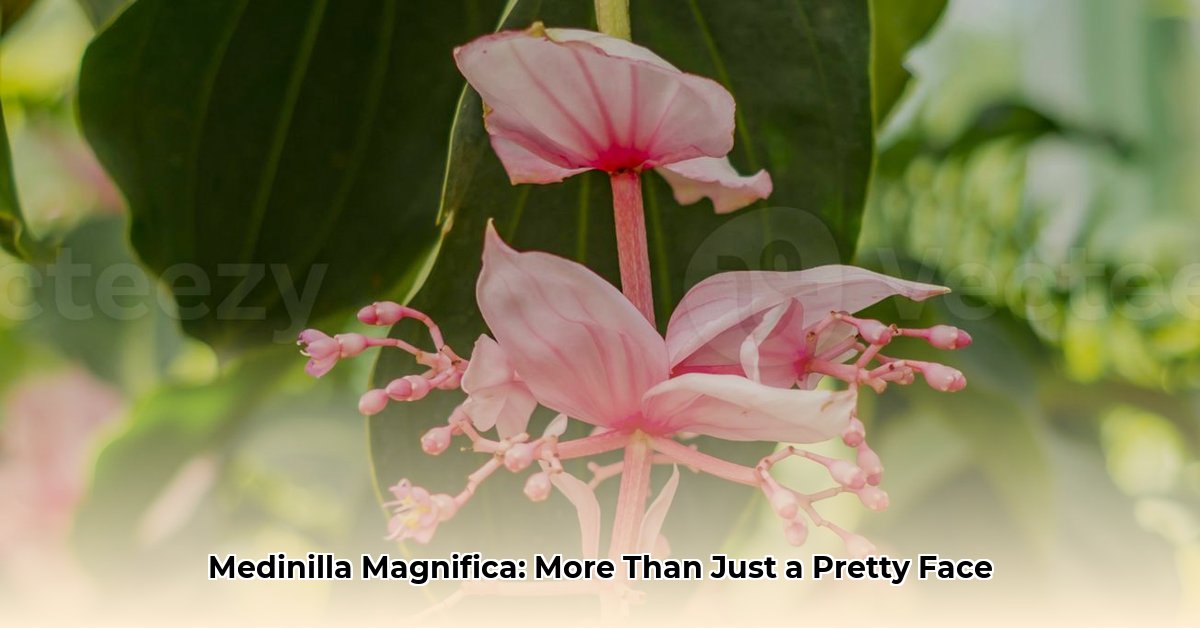Unveiling the Magnificence: An Introduction
The Medinilla magnifica, also known as the rose grape, captivates with its cascading clusters of vibrant pink blossoms and lush, deep green foliage. This tropical gem brings a touch of exotic elegance to any setting, from bright interiors to sheltered patios. Beyond its ornamental value, the Medinilla magnifica holds potential medicinal properties and offers other interesting benefits, making it a fascinating subject for plant enthusiasts and researchers alike. This comprehensive guide explores the diverse uses, care requirements, and intriguing potential of this magnificent plant.
Showcasing the Showstopper: Ornamental Uses
The Medinilla magnifica’s dramatic beauty makes it a natural focal point in various settings:
-
Indoor Display: Elevate your interior décor by placing a Medinilla magnifica in a well-lit spot, away from direct sunlight. A hanging basket allows its pendulous blooms to cascade gracefully, while a decorative pot on a stand creates a stunning centerpiece. Imagine this vibrant plant brightening your living room, dining area, or even a bedroom.
-
Greenhouses and Conservatories: These controlled environments provide the ideal humidity and temperature for Medinilla magnificas to flourish. Picture a collection of these beauties thriving in hanging baskets or perched on stands, creating a lush, tropical haven.
-
Patios and Balconies: In warmer climates (zones 10-11), the Medinilla magnifica can grace your outdoor living spaces. Ensure it receives some shade during the hottest part of the day to protect its delicate blooms.
-
Tropical Landscaping: In tropical regions, these eye-catching plants can be used to create stunning hedges or borders. Imagine a vibrant, living fence adorned with cascading pink flowers.
Beyond Beauty: Potential Medicinal Uses and Benefits
Beyond its ornamental value, the Medinilla magnifica has a history of traditional medicinal applications, particularly in the Philippines. Several cultures believe it may offer the following health benefits:
- Antioxidant Properties: Studies on the extract of Medinilla Magnifica’s stems and leaves indicate promising free radical scavenging activity, suggesting that they might possess antioxidant properties.
- Anti-Inflammatory Effects: In Mindanao, the leaves of the Medinilla Magnifica have been used to manage inflammation and relieve pain from wounds or topical irritations.
- Immune System Support: The leaves are noted for their vitamin C content, which some believe may help to improve immune system function.
- Digestive Health: Traditional uses suggest potential benefits for digestion. The flowers stems can be used for a decoction believed to aid the digestive process and offer some relief to those experiencing diarrhea or other stomach issues.
It’s crucial to note that these potential health benefits are based on traditional uses and preliminary research. Further scientific investigation is needed to validate these claims. Always consult with a healthcare professional before using any plant for medicinal purposes.
Other Advantages and Considerations
- Air Purification: While its primary benefit lies in its beauty, the Medinilla magnifica, like many houseplants, can contribute to modestly improving indoor air quality.
- Non-Toxicity: The plant is generally safe for humans and pets, although the calcium oxalate crystals present in some parts can cause mild irritation if ingested. If you have pets, ensure the plant is not nibbled.
- Non-Invasiveness: Gardeners can rest assured that the Medinilla magnifica is not known to be invasive.
- Non-Edible Fruit: While the fruit may appear tempting, it is not edible.
Nurturing Your Medinilla Magnifica: A Step-by-Step Care Guide
Providing proper care is essential for your Medinilla magnifica to thrive and display its stunning blooms:
- Light: Bright, indirect light is key. Avoid direct sunlight, which can scorch the leaves. An east- or west-facing window, or a shaded south-facing window is ideal.
- Watering: Water thoroughly when the top inch of soil feels dry. Ensure good drainage to prevent root rot, a common problem caused by excessive moisture.
- Humidity: As a tropical plant, the Medinilla magnifica thrives in high humidity (60-80%). Use a humidifier, pebble tray, or regular misting to create a humid environment.
- Temperature: Maintain a consistent temperature between 65-80°F (18-27°C). Avoid drafts and sudden temperature fluctuations.
- Soil: Use a well-draining potting mix rich in organic matter. A blend of peat moss, perlite, and orchid bark works well.
- Fertilizing: Feed every two weeks during the growing season (spring and summer) with a balanced liquid fertilizer.
- Pruning: After flowering, prune lightly to maintain shape and encourage bushier growth. Remove any dead or yellowing leaves.
- Repotting: Repot every two to three years, or when the plant becomes root-bound, using a slightly larger pot and fresh potting mix.
Medinilla Magnifica: A Quick Overview
| Feature | Description |
|---|---|
| Primary Uses | Ornamental; potential traditional medicinal uses (unverified) |
| Benefits | Beautiful blooms, potential contribution to air purification, non-toxic to humans (with care), non-invasive |
| Limitations | Requires specific care, fruit not edible, potential skin irritant (calcium oxalate crystals) |
| Basic Care | Bright, indirect light, consistent watering, high humidity, warm temperatures |
Frequently Asked Questions (FAQs)
- Can I grow my Medinilla magnifica outdoors? Yes, but only in USDA Hardiness Zones 10-11, where temperatures remain consistently warm and frosts are absent.
- Is the Medinilla magnifica poisonous? While generally non-toxic, some have reported skin irritation from the plant’s calcium oxalate crystals. It’s best to err on the side of caution and wear gloves during handling or pruning.
- What are the main uses of the Medinilla magnifica? Its primary use is ornamental. Traditional medicinal uses exist but require further scientific validation.
- Where can I buy a Medinilla magnifica? Check your local nurseries, garden centers, or reputable online plant retailers.
Related Plants
If you admire the Medinilla magnifica, you might also be interested in these visually similar plants:
- Aeschynanthus (Lipstick Plant)
- Columnea (Goldfish Plant)
By following this comprehensive guide, you can successfully nurture your Medinilla magnifica and enjoy its breathtaking beauty for years to come. As research continues, we may uncover even more of its hidden potential, adding to the allure of this truly magnificent tropical treasure.
- Maximize Wisconsin Solar Incentives: Your Guide to Big Savings - September 13, 2025
- Go Solar in Pakistan: Updated 2025 Solar Energy Prices & Best Deals - September 12, 2025
- Free Solar Energy Icons: 10,000+ Vectors & PNG Now - September 11, 2025
















